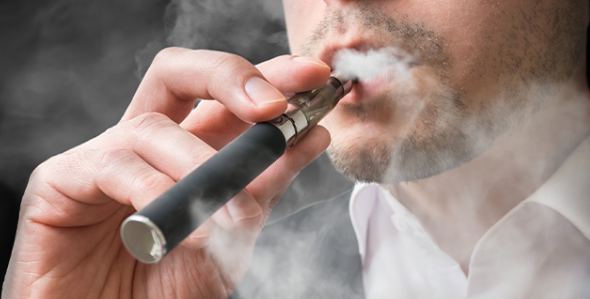FDA safety communication concerning E-cigarettes

Last Updated on September 5, 2019 by Joseph Gut – thasso
September 05, 2019 – An E-cigarette is a handheld battery-powered vaporizer that simulates smoking by providing some of the behavioral aspects of smoking, including the hand-to-mouth action of smoking, but without burning tobacco. Using an E-cigarette is known as “vaping” and the user is referred to as a “vaper.” Instead of cigarette smoke, the user inhales an aerosol, commonly called vapor. E-cigarettes typically have a heating element that atomizes a so-called e-liquid into the vapor. E-liquids usually contain propylene glycol, glycerin, nicotine, flavorings, other additives, and differing amounts of contaminants.

Because of overlap with tobacco laws and medical drug policies, E-cigarette legislation is being debated and introduced in many countries. For example, the revised Tobacco Products Directive of the European Union (EU) came into effect May 2016, providing regulation for e-cigarettes. Similarly, as of August 2016, the American Food and Drug Administration (FDA) extended its regulatory power to include e-cigarettes.
In the community, there is a ongoing, growing, and sometimes rather controversial discussion on the health effects of E-cigarettes. Here is not the place to discuss all these conflicting views. However, fact is that some adverse health effects are seemingly sufficiently serious that health authorities start to intervene. Thus, the FDA posted on August 30, 2019, a safety communication concerned with the rather high incident of severe respiratory disease events associated with use of E-cigarette products. The targeted audiences are consumers, health professionals, personnel in emergency and critical care medicine, and and clinical experts in pulmonology.
Overall, until the end of August 2019, FDA cites 215 possible cases that have been reported from 25 states, and additional reports of pulmonary illness are under investigation. States are completing their own investigations and verifications of cases based on Center for Disease Control and Prevention (CDC) recently released standardized case definition. While some cases in each of the states are similar and appear to be linked to E-cigarette product use, more information is needed to determine what is causing the respiratory illnesses.
In many cases, patients reported a gradual start of symptoms, including a) breathing difficulty, b) shortness of breath, and/or c) chest pain before hospitalization. Some cases reported mild to moderate gastrointestinal illness including a) vomiting, b) diarrhea, and c) other symptoms such as fevers or fatigue. Some patients have also acknowledged recent use of tetrahydrocannabinol (THC)-containing e-liquids while speaking to healthcare personnel, or in follow-up interviews by health department staff.
This latter statement illustrates one of the big problems surrounding E-cigarettes. The e-liquids are many, in very many compositions, and largely unregulated. That means, that even custom-made e-liquids eventually wind up in E-cigarettes, and give rise to exposure of vapers to potentially harmful substances in barely controlled concentrations. It comes as no surprise then that the FDA received samples of e-liquids and continues to receive requests from states to send more samples for the FDA to analyze their composition. The samples represent a variety of different types of products and substances, a number of which contained incomplete information about the product. The FDA is analyzing those samples for their contents, whether they contain nicotine, substances, such as THC or other cannabinoids, or other chemicals and ingredients. The results of that testing will be shared with the respective states to aid in their investigations and will help inform the federal response.
There is definitively more information needed to better understand whether there’s a relationship between any specific products or substances and the reported illnesses. For the time being, it rest to offer recommendations to consumers. Thus, the CDC issued a Health Alert Network (HAN) Health Advisory. The advisory includes the following:
- If you are concerned about these specific health risks, consider refraining from the use of e-cigarette products.
- Anyone who does use e-cigarette products should not buy these products off the street (e.g., e-cigarette products with THC or other cannabinoids).
- Anyone should not modify e-cigarette products or add any substances to these products that are not intended by the manufacturer.
Furthermore, E-cigarette products should not be used by youth, young adults, pregnant women, and adults who do not currently use tobacco products. If you use E-cigarette products, monitor yourself for symptoms (e.g., cough, shortness of breath, chest pain) and promptly seek medical attention if you have concerns about your health.
Should you experience any unexpected E-cigarette-related health or product issues or adverse effect, you are encouraged to report it to FDA on their online Safety Reporting Portal. In other countries, similar reporting possibilities exist.
See here a short sequence on vaping and possible longterm effects:

